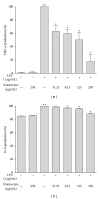Effect of kramecyne on the inflammatory response in lipopolysaccharide-stimulated peritoneal macrophages
- PMID: 23573152
- PMCID: PMC3610359
- DOI: 10.1155/2013/762020
Effect of kramecyne on the inflammatory response in lipopolysaccharide-stimulated peritoneal macrophages
Abstract
Kramecyne is a new peroxide, it was isolated from Krameria cytisoides, methanol extract, and this plant was mostly found in North and South America. This compound showed potent anti-inflammatory activity; however, the mechanisms by which this compound exerts its anti-inflammatory effect are not well understood. In this study, we examined the effects of kramecyne on inflammatory responses in mouse lipopolysaccharide- (LPS-) induced peritoneal macrophages. Our findings indicate that kramecyne inhibits LPS-induced production of tumor necrosis factor (TNF- α ) and interleukin- (IL-) 6. During the inflammatory process, levels of cyclooxygenase- (COX-) 2, nitric oxide synthase (iNOS), and nitric oxide (NO) increased in mouse peritoneal macrophages; however, kramecyne suppressed them significantly. These results provide novel insights into the anti-inflammatory actions and support its potential use in the treatment of inflammatory diseases.
Figures




References
-
- Dung NT, Bajpai VK, Yoon JI, Kang SC. Anti-inflammatory effects of essential oil isolated from the buds of Cleistocalyx operculatus (Roxb.) Merr and Perry. Food and Chemical Toxicology. 2009;47(2):449–453. - PubMed
-
- Nathan C. Points of control in inflammation. Nature. 2002;420(6917):846–852. - PubMed
-
- Rankin JA. Biological mediators of acute inflammation. Advanced Critical Care. 2004;15(1):3–17. - PubMed
-
- Kanno SI, Shouji A, Tomizawa A, et al. Inhibitory effect of naringin on lipopolysaccharide (LPS)-induced endotoxin shock in mice and nitric oxide production in RAW 264.7 macrophages. Life Sciences. 2006;78(7):673–681. - PubMed
LinkOut - more resources
Full Text Sources
Other Literature Sources
Research Materials

